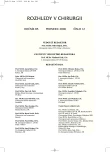The „Inspection Jejunostomy” after Complex Reconstructions of the Central Bile Ducts
Authors:
C. Knorr 1; S. Kastl, HohenbergerW. 2 1
Authors‘ workplace:
Chirurgische Klinik mit Poliklinik der Universität Erlangen, BRD, Dir. : Prof. Dr. W. Hohenberger
1; Chirurgische Klinik Bundeswehrkrankenhaus Ulm, BRD, Leiter: OFA Dr. R. Steinmann
2
Published in:
Rozhl. Chir., 2006, roč. 85, č. 12, s. 624-630.
Category:
Monothematic special - Original
Overview
Introduction:
Hutson and Russell described in 1984 a surgical technique, where a modified Roux-en-Y hepaticojejunostomy with the afferent limb brought up as jejunostomy after complex reconstructions of the central bile duct was performed [4]. It facilitates endoscopic retrograde access to the biliary tree for control examinations and biopsies in complicated reconstructive procedures after bile duct resection. We report our experience with this operative procedure.
Methods:
After having performed complicated bile duct resection, the reconstruction was performed as a modified Rouxen - Y hepaticojejunostomy with the 20 cm afferent limb brought up as terminal jejunostomy in the right upper abdominal quadrant. Postoperative follow-up comprised endoscopic and radiologic controls of the biliary tree every 3 months for one year; ileostomy resection was performed one year later if the postoperative course was undisturbed.
Results:
From 03/1995 to 07/2006 we performed this operation in 25 patients (mean age 62 yrs.). Indications were previous lesions of the common bile duct after laparoscopic (n = 10) or open cholecystectomy (n = 5), common bile duct resections in cholangiocellular carcinoma and gallbladder carcinoma with unclear intraoperative safety margins (n = 4), malignant granulosa cell tumour and simultaneous cholangiocellular carcinoma, focal nodal hyperplasia, Mirizzi-syndrome, cystadenoma of the pancreas head, cyst of ecchinococus granulosos and one patient with intrahepatic recurrent stone formation after orthotopic liver transplantation. The endoscopic and radiologic (cholangiography) diagnostic procedures – performed every 3 months postoperatively – were uneventful.
Conclusions:
The modified Roux-en-Y hepaticojejunostomy with the afferent limb brought up as jejunostomy permits good control and intervention possibilities in complicated bile duct surgery after bile duct lesions, tumor resection with unclear resectional margins and in recurrent intrahepatic stone formation.
Key words:
biliodigestive anastomosis – jejunostomy – biliary complications – bile duct stenosis
Labels
Surgery Orthopaedics Trauma surgeryArticle was published in
Perspectives in Surgery

2006 Issue 12
Most read in this issue
- Consequennce of Nontreatment Scapholunate Instability of the Wrist
- Anterior Skull Base Reconstruction
- Autovenous Ilicofemoral Bypass, 21 Years Later – A Case-Review
- Gastric Carcinoid – A Case Review
